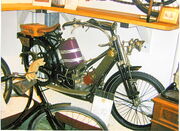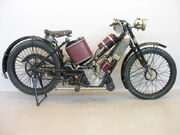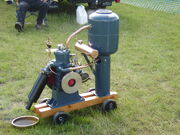 | |
| Fate | Voluntary Liquidation |
|---|---|
| Predecessor | Scott Engineering Company |
| Founded | 1908 |
| Defunct | 1969 |
| Headquarters | Bradford, West Yorkshire, England |
| Key people | Alfred Angas Scott |
| Products | motorcycles |
The Scott Motorcycle Company was owned by Scott Motors (Saltaire) Limited, Shipley, West Yorkshire, England and was a well known producer of motorcycles and light engines for industry. Founded by Alfred Angas Scott in 1908 as the Scott Engineering Company in Bradford, Yorkshire,[1] Scott motorcycles were produced until 1978.[2]
Development[]
A gifted engineer, Alfred Scott was a pioneer of the development of the two-stroke engine and after some experiments with one of his engines fitted to a Premier bicycle, Scott designed and patented a vertical twin two stroke engine in 1904 and developed a complete motorcycle from scratch featuring a 450 cc two-stroke twin cylinder engine mounted in a triangulated frame. Innovative features included a two-speed chain transmission in which the alternative ratios were selected by clutches operated by a rocking foot pedal and a kick start, which he is credited with inventing.[citation (source) needed] The first few machines to his design were produced by Bradford based car firm Jowett in 1908 and soon after he set up as a manufacturer in his own right at premises in Grosvenor Street Bradford.[1]
Pre-war competition success[]

1913 Scott 550cc
While Scott's production machines were marketed as a kind of luxury 'wheeled horse' for the Edwardian Gentleman,[3] there was valuable publicity to be had in competition success and the early Scott motorcycles were so powerful that they often easily beat four stroke motorcycles of the same capacity. So event organisers deemed the Scotts to be "overly efficient" and penalised them by multiplying their cubic capacity by 1.32 for competitive purposes, which of course resulted in good (free) advertising for Scott.[4]
Scott made several appearances at the Isle of Man TT Races between 1910 and 1914 with specially built racing machines.[5] In 1910 a Scott was the first two-stroke motorcycle ever to complete a full TT course under race conditions and in 1911 a Scott ridden by Frank Phillip gained the TT lap record of 50.11 mph continuous average speed. This winning streak continued with Scott's being the fastest machines in 1912,1913 & 1914 as well as winning the event in 1912 and 1913.[4]
First World War[]
The outbreak of the First World War in 1914 halted production of civilian Scott motorcycles. Alfred Scott developed a three wheeled machine gun carriage which was not taken up by the military and in 1919 he left the company he had founded to develop the vehicle for civilian use as the Scott Sociable. This did not prove to be as successful as the Scott motorcycle but Scott never returned to the Scott Motorcycle Company.[4]
The Scott Squirrel[]

1923 Scott Squirrel 486cc
After the war production restarted with the 532cc 'Standard Tourer' and in 1922 Scott introduced the famous Squirrel, its first sporting model to be offered to the general public. This had a slightly smaller 486cc engine to bring it within the 500cc competition limit but, with aluminium pistons and careful preparation, it produced more power. In addition, many heavy accessories such as foot boards and leg shields which had been fitted to the touring models were dispensed with, making it a very light and competitive motorcycle. It was followed by the Super Squirrel, with a further revised engine of 498cc or 596cc, which was the mainstay of production in the mid 1920s. Although they never regained their pre-war form, Scotts continued to compete successfully in sporting events scoring a 3-4 in the 1922 TT and a third in 1924. A three speed gearbox with conventional clutch was offered from 1923 and in this form the machine had some success as a trials motorcycle.[2]
The Second War[]
In 1935 the Scott Three cylinder motorcycle was launched as a water cooled 750cc in-line machine. This was superseded by the 1000cc version and proved to be another example of innovative engineering by the Scott company. Neither made it into quantity production, however, due to the outbreak of the Second World War and the failing business finances.[4]
The Flying Squirrel[]
- Main article: Scott Flying Squirrel
Shortly after the end of the Second World War (1946/7) Scott relaunched the Scott Flying Squirrel. Available with 500 or 600cc engines, these were even heavier than the pre-war versions and expensive for the performance offered. Sales were disappointing and the company went into voluntary liquidation in 1950.[4]
Birmingham Scotts[]
In 1950 the company went into liquidation and was acquired by Scott enthusiast Matt Holder's Aerco Jig and Tool Company in Birmingham. From his premises in St Mary's Row, Holder, who was an expert silversmith initially continued to build the same model from Shipley made spare parts. These 'Birmingham Scotts' remained available into the 1960s. 1n 1956 Holder began development of a 596cc model with a duplex frame and telescopic fork front. When Matt's son David Holder move the remaining stock to the former Triumph Motorcycles factory at Meriden he found that his father had accumulated a huge collection of original Scott parts, including Miller headlights and Burgess silencers. In 1958 the 'Birmingham Scott' was updated by adding a swinging arm frame and the dynamo was replaced by an alternator. A new 493 cc motorcycle called the Scott Swift was announced but never went into production but Holder continued developing and producing one off Scott motorcycles until 1978. [6]
The Bulmer workshop[]
Fabricator Brian Bulmer teamed up with two-stroke engine tuner Brian Wolley and rider Barrie Scully to develop a racing version of the Birmingham Scott air cooled 350cc twin, setting a record for the Barton Hill Climb and achieving 115.4mph in a Motor Cycling test. The team also developed a 52 bhp water cooled 500cc version but competition from Japanese two strokes meant that the project was fully developed.[6]
Silk Scotts[]
The 1970s also saw the launch of the George Silk Scott. Based on the Birmingham engine, manufacturing rights prevented Silk from building copies of the engine so they designed their own.[4] Effectively one-off bespoke motorcycles, only about 20 were produced in the late 1960s and early 1970s, with the last being made in 1975.[7]
Stationary engines[]

A rare 1930's Scott Type SE no. 304
In the 1930s Scott manufactured a number of stationary engines with the aim of raising funds following the decline in motorcycle sales. Some of these engines were derived from motorcycle units, for instance the DSE was a watercooled version of the Lightweight Squirrel engine and the SE had the same bore and stroke dimensions as the long stroke Flyers. The PA stationary engine however was different. Designed to meet a Ministry requirement for a portable electrical generator for the Bofors anti-aircraft gun and its Kerrison Predictor, it was produced during World War II both by Scott and its former partners Jowett.[8] It was air cooled, petrol lubricated and featured a loop scavenge design with two opposed main transfer ports supplemented by a third 'boost' port opposite the exhaust.[9] This arrangement was patented by Scott in 1939[10] but is often mistakenly believed to be of post war origin as it was later widely adopted for motorcycle racing engines and power boats after its 'reinvention' in the late 1950s by East German motorcycle manufacturer MZ.[11]
Product range[]
- Motorcycles
- Scott Flying Squirrel
- Scott Sociable
- Scott Model 3S
- Engines
- Scott type SE
- Scott type DSE
- Scott type PA
Preservation[]
How many examples survive ?
A number of surviving examples are on display in the Bradford Industrial Museum with their collection of Jowett cars in the transport Gallery.
Template:PML Scott Motorcycle
See also[]
- Alfred Angas Scott
- List of Motorcycle manufacturers
- List of Engine Manufacturers
References[]
- ↑ 1.0 1.1 De Cet, Mirco (2005). in Quentin Daniel: The Complete Encyclopedia of Classic Motorcycles. Rebo International. ISBN 978-90-366-1497-9.
- ↑ 2.0 2.1 Brown, Roland (1999). The History of British Bikes. Parragon. ISBN 0-75253-153-0.
- ↑ Smith, Philip.H (1965). The High Speed Two-Stroke Petrol Engine. Foulis, 87.
- ↑ 4.0 4.1 4.2 4.3 4.4 4.5 "Scott History". Retrieved on 2008-12-27.
- ↑ Smith, Philip.H (1965). The High Speed Two-Stroke Petrol Engine. Foulis, 87–91.
- ↑ 6.0 6.1 Reynolds, Jim (1990). Best of British Bikes (in English). Patrick Stephens Ltd. ISBN 1-85260-033-0.
- ↑ "Silk-Scott Special". Retrieved on 2008-12-27.
- ↑ Gallimore, Phillip (Dec.1983,Jan.1984&Feb.1988). Scott Stationary Engines, Stationary Engine Magazine issues 118,119 & 168. PPG.
- ↑ "Of pistons and ports". Retrieved on 2009-01-06.
- ↑ "Patent for Improvements in or relating to the scavenging of the cylinders of two-stroke-cycle internal combustion engines". Retrieved on 2009-01-06.
- ↑ Bossaglia, Cesare (1968). Two-Stroke High Performance Engine Design and Tuning pages 96 & 97. Lodgemark Press.
External links[]
| ||||||||
| This page uses some content from Wikipedia. The original article was at The Scott Motor Cycle Company. The list of authors can be seen in the page history. As with Tractor & Construction Plant Wiki, the text of Wikipedia is available under the Creative Commons by Attribution License and/or GNU Free Documentation License. Please check page history for when the original article was copied to Wikia |